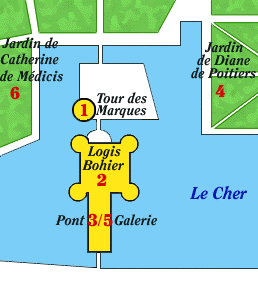|
1547: It was given as a gift to Diane
de Poitiers, lover of King Henri II. It was her idea to
build a bridge over the Cher connecting the square pavilion
to the opposite bank of the river (3). She also had the parterres
laid out in the Italian style by the gardener of Amboise,
Pacello da Mercoliano (4).
1559: Catherine de Medicis, widow
of Henri II, took over the chateau after having driven away
her rival. She asked the architect Philibert Delorme to
build a 2 level gallery on Diane's bridge (5). Bernard Palissy laid out the
gardens for her (6), and
she started the construction of the outbuildings.
1733: Chenonceau was purchased by the
farmer-general Dupin. Madame Dupin liked to "hold
salons". Chenonceau once again had its former splendor and
became an important pole of literary activity. The tutor of
the Dupin boys was a certain Jean-Jacques Rousseau. It was
here that he wrote "L'Emile". Much liked by the villagers,
Mme Dupin was able to avoid the pillage and destruction of
the chateau during the Revolution.
1863: Dame Pelouze bought the
chateau and spent 10 years restoring it, keeping the chateau
from falling into ruins.
The estate has belonged to the Menier
family, famous chocolate makers, since 1913.
Visit the interior of the
chateau
|

|
Precious
Gallery
|
|
During the First World War the gallery of
Chenonceau was used as a hospital for soldiers
wounded in the trenches.
During the Second World War it helped lead
many people to freedom. The demarcation line that
cut France in two followed the Cher. The chateau
was in the occupied zone, but the end of its
gallery was in the free zone...
|
|

